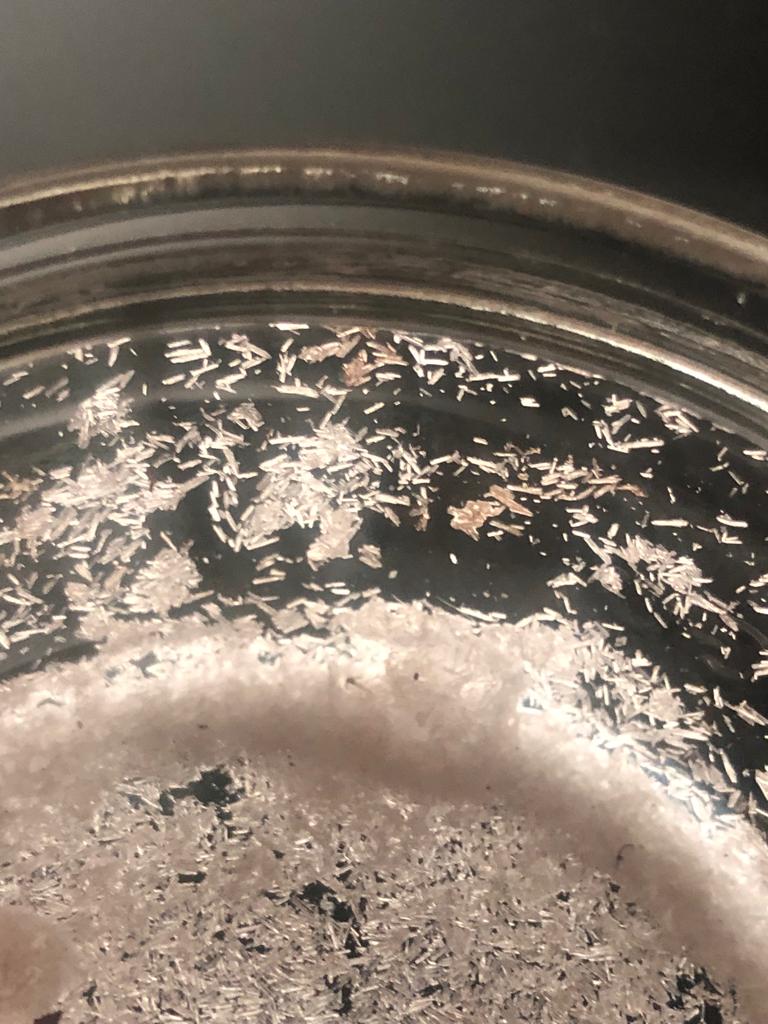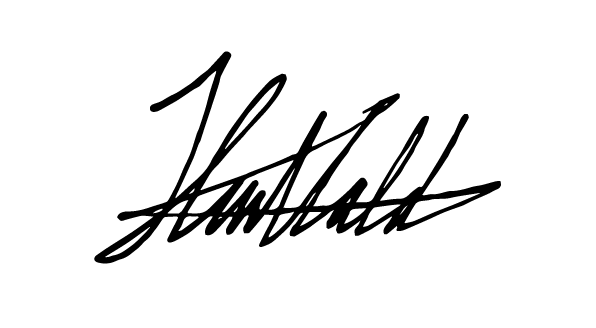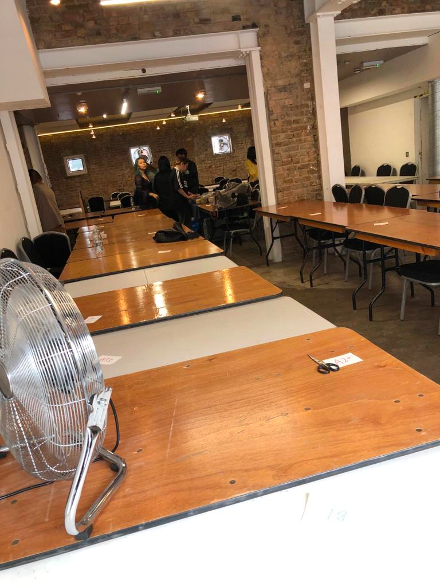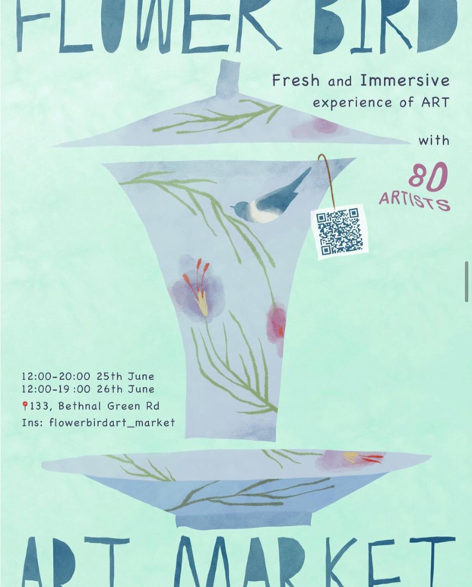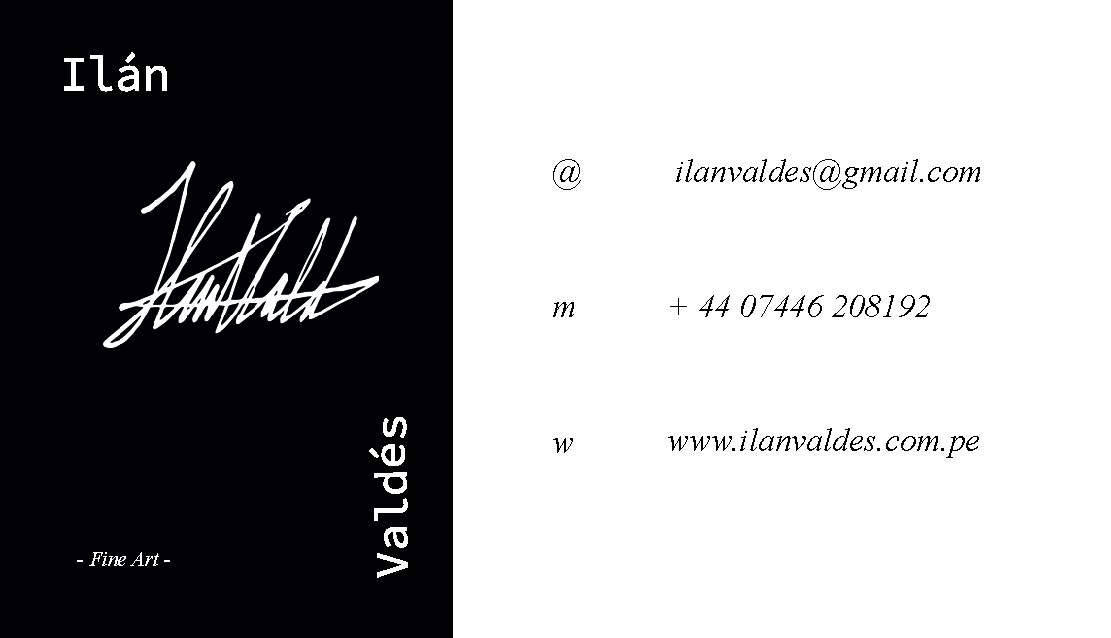PROFESSIONAL SKILLS
& CAREER PATHS
I will start this section by talking about two experiences I had during this unit. One of them was positive and the other one was not. After that, I will expand on connections and opportunities I have built to showcase my work in the future. I will finally make a balance to understand where further prospects can be developed and the challenges I have found when trying to find exciting opportunities for the future.
The first experience was the Flower Bird Market at Shoreditch, where I had a stand with the opportunity to sell my work for two days. As soon as I arrived, I realized they had confirmed too many artists for the space they had available, so when the artists arrived it was so cluttered you couldn’t walk through the space. The participation fee was 35 pounds.
On the first day, I took small paintings and display them on a table, then I would change the table as the day went by. I didn’t make a sale that day. Someone told me it might have been because I looked sad, which was either rude or somewhat true. I also realized the importance of showing the price next to the pieces, as I later found out it was a standard in that type of business model.
An unexpected effect was the fact that it made me feel insecure about my pictorial work. There is a breach between how good you feel your work is and the context in which it is shown. But either way, I decided to make radical changes to my display for the next day.
For the second day, I printed Polaroids and changed the A4 format to a square cardboard paper, which is a more unusual format. I then pasted the Polaroids in the middle. I still put some illustrations and A4 photographs in the corner to see what happened. I sold two photographs and an illustration that day. I almost recovered the money it costed me to be there, however I learned the importance of price-tagging as well as making sure the fairs I worked at were well established and not in a context of experimental amateur over-sold projects.
The experience was very different to what I expected; however, it was a huge learning experience.
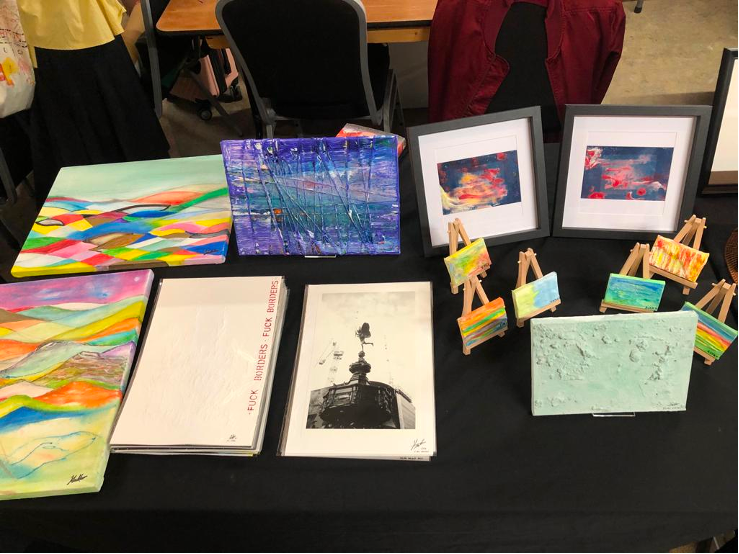
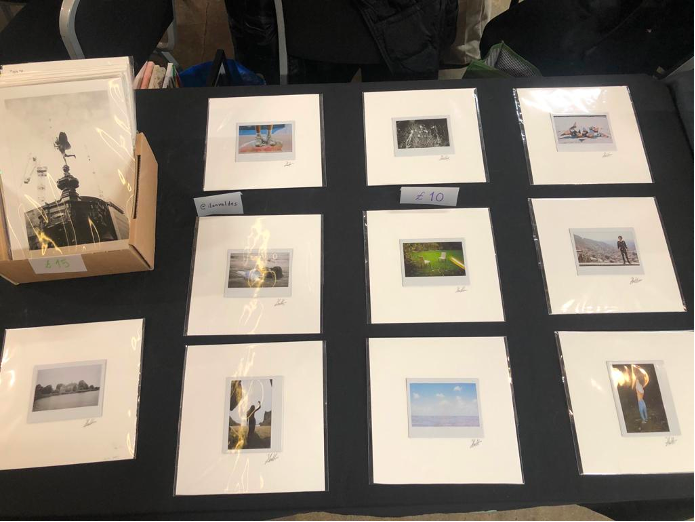
A good experience I had, however, was to get signed by a new gallery, Swanfall. The gallery was founded by Pandora Wang. This was great as I know her and her work and have a strong belief in it as I think it expresses the difficulties of being a contemporary artist with high standards put upon oneself. I also like the gallery’s approach to art, promoting emerging artists.
My experience with the gallery so far has been very good. The agreement with Swanfall started with a paid promotion to display my polarization work. This caught the attention of a buyer who offered £2500 for an NFT of the 35cm polarized piece I did with the landscape photograph print.
This opened up a bunch of questions for both me and the gallery. This was the first learning experience, as I wanted to discuss the legal terms of the NFT ownership, and that dissuaded the client who stopped replying. This experience however, also opened up questions regarding pricing, intellectual property of reproducibility and technical space cost calculation.
The fact that I have spent these months in a secure environment where the technical spaces were at hand, in a way subsided the cost of the pieces as well. For the future, I will need to make a budget of the real costs in order to offer a price. I am still looking forward to the upcoming sessions where these subjects will be addressed. Also, the speed in which one acts is crucial, as having certain questions in these environments is seen as unprofessional and dissuades the potential client.
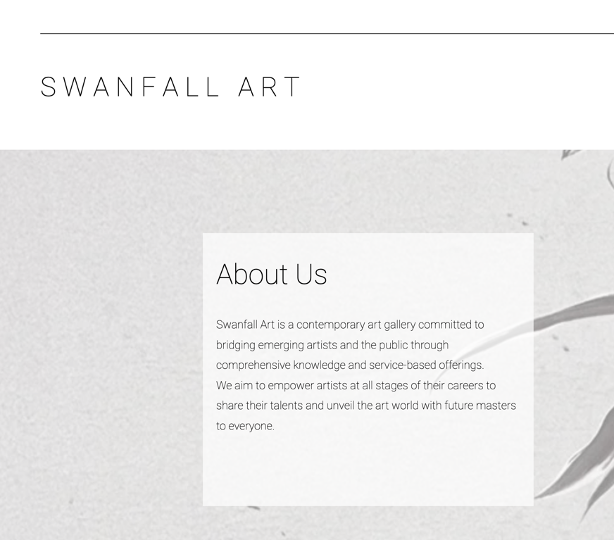
I signed a five-page non-exclusive contract with Swanfall that gets renewed yearly automatically. The gallery’s compromises are the following:
“1. Present the Artist’s work every year on the online gallery;
2. Organize exhibitions from time to time, producing catalogues and invitations;
3. Maintaining visual material for promotional purposes;
4. Maintaining media archives/records of promotional activities/post-show summaries of media
outcomes and promotional material;
5. Pursuing ongoing sales and exhibition opportunities outside the gallery in the public and private
sector (e.g., in museums, public galleries, festivals, survey shows, biennales);
6. Pursuing commissioning opportunities and advocating for the Artist’s interests;
7. Cultivating collectors and corporate clients;
8. Pursuing critical writing and publishing opportunities for the Artist;
9. Recording of all works left on consignment, location of all works sold and on loan;
10. Featuring the Artist’s works in catalogues, invitation, visual material for promotional purposes.” (Swanfall, 2022)
It is interesting to see the original Artist Statement I presented in August and how much it has changed in four months. The interests are similar, however my focus on perception has increased over my interest in identity, as that subject can be approached as a consequence more than a direct experience.
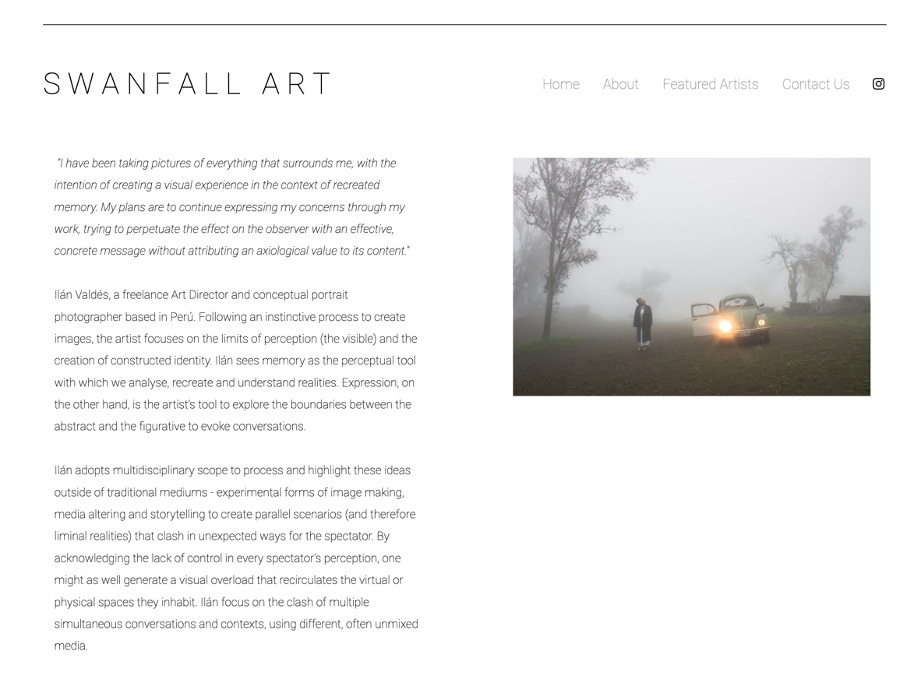
Being this my first contract with a gallery or an artist contractual agreement, I believe this document can be very useful as a reference in case I want to open a gallery in the future, or make a formal agreement with colleagues. This agreement was made in August, so I believe this agreement will be useful in the future as it is the result of working hard and making connections.
Another meaningful relationship came up from a conversation that the piece “Unknown realities” catalyzed at Dilston gallery. Elena Isayev approached me to ask me why I chose AI instead of other type processed image. My answer was that it related with our biased perception, and the fact that certain animals could see this piece the way we were seeing it, but that we needed an extra device to access that version of what is not usually seen.
She immediately called her friend Catrin Webster, who I didn’t know was the head of the MA at the time. Neither did I know that Elena Isayev was a professor of Ancient History and Place who is currently researching AI and its effects. She emailed me the next day offering me to showcase my work in an upcoming presentation she was giving on Kaunas, with a project relating to T-Factor (https://www.t-factor.eu/ ).
I sent her my updated Artist Statement and some reflective texts about the “Unknown Realities” piece, as well as the best photographs I had taken. However, it was also a great learning experience as well. I believe the second unit gave me the confidence to identify the points of interest that the piece has and the different approaches one can take depending on the spectator’s interests.
I found the importance of having a personal business card with information to stack under the piece, which I hadn’t done before. This allowed me to connect with Elena as well as provide information in the moments where I cannot be next to the piece. The information I included was my e-mail, telephone number and web page link. On the front was a photographic image taken in 2016 for “Látex” next to a distorted cellophane scan made in 2021 during the course.
The color of the print on the left is referential and does not correspond to the printed cards
Since then, I have also continued updating a database I built to track different artists, galleries, publishers and researchers. I find the process of tracking applications and submissions difficult, so I am working on ways I can find a visual scheme to organize them to make that task easier. For mi it’s interesting that researchers whose papers and research are difficult for me to understand are harder to approach, but I believe maybe there could be aspects they are interested in that I can help with.
It is also important to learn to ask for support, as well as knowing where it is available. However, I am working on developing the ability to open new, unusual doors that can lead to exciting new outcomes.

Another interest of mine is to try to reach different big companies who could benefit from multidisciplinary artist practice to evaluate its corporate work. The duty manager at the Serpentine Gallery recommended me two agencies for artists that I plan to contact in order to have conversations to give clue of the stability I am looking for. Agencies are better at finding jobs as the online search can become overwhelming and sometimes leads to nothing more than getting spammed.
In relation to my future research, I intend to continue looking into perceptual shift recognition as a trigger for social change. I want to continue developing the idea behind that by acknowledging simultaneous difference, or reality coexistence. There is a reinterpretation of the natural “principles” taken for granted. The physical shift that occurs when polarizing solid colors, is a homage to subversive aspects of simplicity.
I am interested in humans’ perception of reality; I believe it is biased and I am currently building models to show these ideas through perception phenomena. I am also interested in the different interactions for the generation of ideas and how we are equipped to understand our surroundings.
I will continue making further connections with profit and nonprofit galleries and studio spaces such as Studio Voltaire or VO Curations. Also, I intend to continue making connections with artists and scientists such as John Goodby, Charles Bradbury or Stephen Cowling who keep inspiring me with the photographic work they do polarizing liquid crystals:
https://www.cell.com/pictureshow/liquid-crystals
By having a multidisciplinary experimental practice, a lot of resources are needed and space becomes a scarce necessity. Also, being a painter, scarce resources become more difficult to find in uncertain environments. This is why I intend to continue doing my practice and networking in order to make it sustainable and grow.
I asked a friend who is a curator what the way of “making it” was. His answer was that the best way to increase the chances of that happening is by making work without stopping and improving it. This process has also taught me the importance of doing the opposite by taking time to look back, take pauses and respect my own times and rhythms, as well as the schedules and ideas the piece requires. I believe there is a space in the middle, where you can be productive, but also make sure that the work you make is meaningful, with a high-end finish and design. To accomplish this, I have also realized the importance of selecting and curating potential opportunities. This way of picking the versions might also be also something I learned from the piece I built.
